Char Dham Yatra is of great importance, especially to Hindu people. The pilgrims believe that the Char Dham yatra eliminates all their sins and opens the door to “Moksha”. Every human being should consider visiting these four holy places at least once in his life.
Millions of worshipers visit this sacred yatra and pay tribute to the temples each year. It is commonly accepted that taking a trip to these places of pilgrims will eliminate all the sins and mistakes you have made in your past life. Yatra gives you a sense of belonging, a purity of heart and gives you a personal update in your life.
The Hindu Char Dham (consisting of 4 divine temples) is one of the most sacred Hindu Temples which includes Badrinath, Puri and Dwarka. Although the origins are not clearly known, the Advaita Hinduism School created by Sankaracharya, who created Hindu monastic institutions throughout India, attributes the origin of Char Dham to the seeker. The four monasteries are found across the four corners of India and their temples are the Badrinath temple in Badrinath in the north, the Jagannath temple in Puri in the east, the Dwarakadheesh temple in Dwarka in the west and the Ramanathaswamy temple in Rameswaram to the south Although ideologically, the temples are divided between the sects of Hinduism, namely the saivism and the Vaishnavism, the pilgrimage of Char Dharma is a totally Hindu affair. Chota Char Dham (Chota means small) consists of four dwellings: Badrinath, Kedarnath, Gangotri and Yamunotri – all located in the foothills of the Himalayas. The name Chota was added in the middle of the 20th century to differentiate these temples from the original Char Dham. The journey through the four cardinal points of India is considered sacred by Hindus and many Aspire visit these temples once in their life. Traditionally, the journey begins at the eastern end of Puri and continues in a clockwise direction, as generally followed in Hindu temples.
Adi Shankaracharya, the eighth century philosopher and reformer who was credited to the revival of Hinduism, was also responsible for coining the words Char Dham, referring to the four holy abodes of the lord Vishnu. During his extensive tour throughout India, he also established Mathas in those four places dedicated to the research and preservation of four Vedas. Jyotir Matha is an example at Badrinath, was assigned the task of maintaining and preserving the Atharv Veda. Sharada Matha at Dwaraka was assigned the task of maintaining and preserving the Sam Veda. Govardhan Matha at Puri was assigned the Rig Veda and Sringeri Matha at Sringeri hills in the South India was assigned the Yajur Veda. These four pilgrimage places in India are considered to be the most holy places in this universe for Hindus. They are Badrinath, Dwarka, Jagannath Puri, and Rameshwaram. The Char Dham defined by Adi Shankaracharya consists of two Vaishnavite, one Shaivite, and one mixed site. Geographically the Char Dham makes a perfect square with Badrinath and Rameswaram falling on the same longitude and Dwarka and Puri on the same latitude, representing the farthest north, east, west, and south points of India at the time of Adi Shankara. However, there is another Char Dham usually known as “Chota Char Dham” located in the close proximity of the Himalayas. As opposed to the predominantly Vaishnavite Char Dham coined by Adi Shankara, Chota Char Dham represents all three major Hindu denominations (Shaktism, Shaivism and Vaishnavism). It includes Yamunotri and Gangotri representing Shaktism, Kedarnath representing Shaivism, and Badrinath representing Vaishnavism. It is a common Hindu belief that Lord Vishnu takes his bath at Rameswaram (in Treta Yuga), meditates at Badrinath (in Satya Yuga), dines at Puri (in Kali Yuga) and retires at Dwaraka (in Dwapara Yuga).
Shri Badrinath Temple:
The temple of Badrinath in the north, the home of Shri Badrinath is also called “BhuVaikuntha”, which means Lord Vishnu’s land dwelling. Badrinath is located in the Himalayas, on the banks of the Alaknanda River, in the state of Uttrakhand.
Dwarka Temple:
The temple of Dwarka is in Gujurat, the home of Lord Krishna, is also known as Jagat Mandir. There are two main gates to and from this temple: the entrance is called Swarga Dwar and the exit is called Moksha Dwar, near the Gomati River.

Puri Jagannath Temple:
The Puri Temple in Odisha is the home of Lord Jagannatha, Balabhadra, Devi Subhadra and Lord Sudarsan. Jagannath means the lord of the universe. Puri is also famous for its Rath Yatra (Car Festival) where three chariots gather in procession with Lord Jagannath, his brother Lord Balabhadra and his sister Devi Subhadra.
Rameshwaram Sri Ramanatha Swamy Temple:
Rameshwaram Temple, the home of Sri Ramanatha Swamy (Lord Shiva), is located in the southern state of Tamil Nadu. It is located in the Gulf of Mannar, at the tip of the Indian peninsula. This temple is also one of the twelve Jyotirlingas of Lord Shiva in India.
According to Sanatana Dharma, life is divided into four stages called Ashrams that include Brahmacharya, Grihastha, Vanaprastha and Sanyasa. The last stage of life is the actual preparation for the final liberation. Pilgrimage and austerity are the most important characteristics of this phase of life. It is also a general belief that traveling to places of pilgrims erases his sins and can help him reach Moksha. Therefore, the Dham Char are considered extremely sacred for all Hindus and the pilgrimage to Char Dham at least once in life is a dream come true for many.
In addition, Adi Shankaracharya deliberately established these four temples throughout India during the eighth century, with the aim of reviving the Hindu religion and unifying all Hindus in the country.
